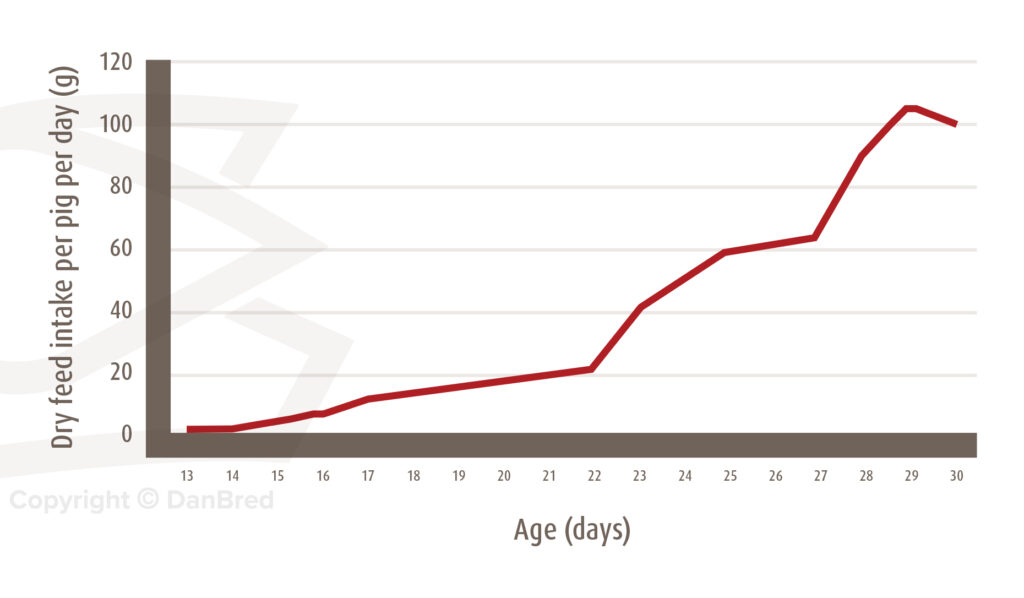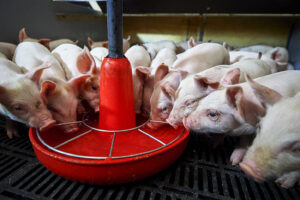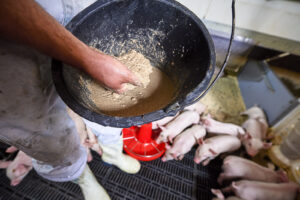Weaning – The foundation for success
Content
Rearing many high-quality piglets
Successful rearing of many high-quality piglets is highly related to the transition from a milk-based diet to a solid feed diet. Correct handling will maximise daily gain and piglet growth rates.
How to lay the foundation for successful weaning
The successful rearing of many high-quality piglets is highly related to the transition from a milk-based diet to a solid feed diet. Starting this transition in the farrowing unit will reduce the risk of post weaning growth lag as well as post-weaning diarrhoea while continuing to maximise daily gain and growth rates.
Increase success rate in the weaning section


Regardless of production type, weaning is a stressful event for pigs. Successfully managing the change from a liquid based diet to feeding solid food can significantly help to reduce this stress. Many pigs will undergo a post weaning growth lag (PWGL) in the 3-7 days after weaning. The use of creep feeding to start the change from milk to solid feed initiates a transformation in the digestive system of the pigs in order for them produce enzymes that digest the nutrients in solid feed (DPRC, 2010). Furthermore, creep feeding has been shown to increase weaning weight, average daily gain post weaning as well as reduce PWGL (Eastwood, 2018).
Offering creep feed to piglets from of 7-10 days will train the piglets to not only eat solid food but will also help stimulate their digestive enzymes. Feed intake will vary between the piglets but slowly increasing the feed allowance reaching ad lib feeding around the age of 3 weeks is the currently recommended strategy (DPRC, 2018).
To ensure hygiene and to keep the piglets interested in the feed, always feed small amounts many times a day and ensure the troughs are clean and dry before feeding.
It is also good practice to have the pigs consume all the creep feed before the next feeding to assure hygiene and reduce the risk of diarrhoea (DPRC , 2018). To increase piglet feed intake, increase the number of feedings instead of increasing feed amount per feeding. Start by feeding twice a day and build up to feeding the piglets 4 to 5 times a day (DPRC, 2010).
Due to rapid growth rate, new born piglets require a higher amount of iron than the deposit they are born with or the amount which can be supplied from sow milk. Ideally piglets should receive a minimum of 200 mg iron within the first week to support daily gain as well as their immune system (DPRC, 2017).
Easy steps for increasing weaning transition success
 Maximise creep feed intake in the farrowing unit
Maximise creep feed intake in the farrowing unit
- Start creep feeding at the age of 7-10 days.
- Offer feed of high-quality and highly-digestible ingredients. Ideally the feed used in the farrowing unit is the same as the 1st stage feed after weaning.
- Feed small amounts frequently.
- Ensure good hygiene and keep feeders clean.
- Offer the feed when the sow is eating and the piglets are awake.
- Consider providing a liquid creep feed mix to promote early feed intake.

Feedings
When feeding, it is important that the pigs empty the trough within 20 to 30 minutes
- Age of 7-10 days = feeding 2 x / day
- Age 11 -20 = feeding 3 x / day
- Age 21 days+ = feeding 4-5 x / day

Water and hygiene
Reduce the risk of bacterial growth by rinsing the troughs after each feeding
- Water in the trough after each feeding can serve as extra drinking water
Liquid creep feed mix
Starting the piglets on a liquid mix can help the transition from milk to starter feed as the liquid texture is similar to that of milk.
- Mix together 5 parts water, 1 part milk-replacer and 2 parts starter feed.
- Provide 1 litre of liquid mix per 10 pigs.
- The piglets must empty the trough in 20 to 30 minutes.
The liquid mix can be used in both the farrowing unit as well as after weaning.
Iron
Ensure optimum growth and health by the administration of a minimum 200 mg iron to each piglets.
- Administer iron within the first week of life.
- Administer iron orally or by injecting it into the neck or groin.
- If using drinking iron: check regularly for blockage or dripping valves.
- Administer extra iron by injection to pale, slow growing piglets.
References
Eastwood, L..(2018): Creep Feeding to Improve Piglet Performance. Ontario Ministry of Agriculture, Food and Rural Affairs (OMAFRA) Factsheet ISSN 1198-712X
Danish Pig Research Centre (DPRC) (2010): Fodring af pattegrise. SEGES Videncenter for Svineproduktion. Retrieved 22/02/19. https://svineproduktion.dk/Viden/I-stalden/Foder/Udfodring/Pattegrise
Danish Pig Research Centre (DPRC) (2017):Jernbehandling. SEGES Videncenter for Svineproduktion. Retrieved 22/02/19 https://svineproduktion.dk/viden/i-stalden/management/faring/jernbehandling
Danish Pig Research Centre (DPRC) (2018): H23 – Feeding of piglets, Manual om farestaldsmanagement. SEGES Videncenter for Svineproduktion. Retrieved 22/02/19 https://svineproduktion.dk/Viden/I-stalden/Management/Manualer/Farestald




